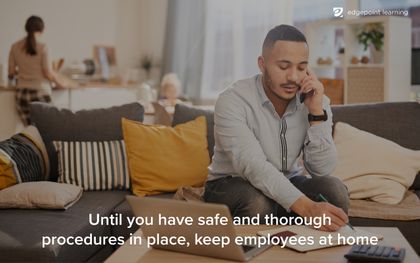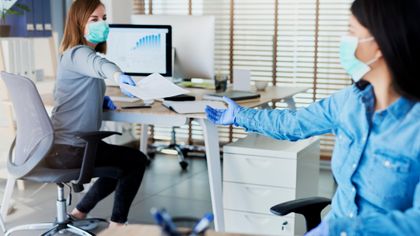COVID-19 Office Safety: How To Prepare Your Workplace
Corey Bleich
🍿 6 min. read
The world is entering another month of uncertainty with the COVID-19 pandemic. In many places stay-at-home orders are being gradually lifted. While some businesses are changing their entire model to stay remote for the long-term, more and more businesses are opening up. As many areas begin to welcome employees back into the workplace, COVID-19 office safety is at the top of everyone’s mind. How will you keep employees and customers safe as restrictions ease? From transmission reduction to sanitation and flexible work routines, this is our guide to getting started.
Make sure your office is ready
The first step in COVID-19 office safety is to make sure that your physical office is ready. Assign one person, or one larger team, directly in charge of putting all procedures in place and following through with them goes on. This one point of leadership is vital.
If your industry or sections of your workforce can continue working remotely, heavily consider doing so. Reducing in-person contact in workplaces that are nonessential can reduce the burden and potential transmission for essential workers and others.
If that isn't possible, or you need some employees to return to the workplace due to the work they do, start by developing a checklist of opening procedures. These should address every aspect of the physical space and your efforts. Consider the following:
- Which spaces have the highest potential to spread infection, and how can they be modified?
- How can you space out shared work areas?
- Where do people enter and exit areas, and is there room to maintain distance?
- Is there space and protection for reception that includes contactless delivery?
- How is the office set up to accommodate social distancing guidelines?
- Where will employees eat? Have meetings? Host clients?
- Can you stagger in-office times or days?
Further, as if sanitation considerations for COVID-19 were not enough, there are some questions about health risks that can occur when offices sit dormant for long periods of time. Stagnant water in pipes can carry a host of respiratory illness, including Legionnaires’ disease. If your business has not been in regular use during the lockdown, your pipes will need to be flushed and drained or treated with disinfecting solution to kill any bacteria that has developed.
These considerations are an important first step in returning to work after COVID-19, one that can show employees and customers that you are actively keeping them safe at work. Until you have safe and thorough procedures in place, plan to keep employees at home.

Reduce potential transmission
When it comes down to it, other people are the primary source of infection. It’s a hard truth, but the best way to reduce potential transmission is to put measures in place that identify potential infection early (and help healthy workers stay that way!).
These measures include:
- Taking contactless temperatures of everyone as they enter the building and sending anyone home with a higher temperature
- Reconfiguring the office so that no one spends time working face-to-face with another person
- Encouraging sick employees to say home (with appropriate pay and support)
- Avoiding all unnecessary travel both out of state and to local meetings
- Adding stocked hygiene stations throughout the office
- Posting signage that encourages handwashing and one-way, distanced movement through the office
- Limiting the number of people in the office at any given time (more on this below)
- Requiring mask usage in common or shared areas (more on this below)
- Switching to mobile credentials to open doors (instead of keypads)
- Removing or blocking off fabric surfaces that can't be easily sanitized (e.g., chairs and pillows)
Because up to 80% of COVID-19 cases may be asymptomatic, preventative measures like the ones listed above are crucial to help prevent community spread.
Increased sanitation measures
More research is published every day on COVID-19 and how it is transmitted. While the guidelines at the end of May 2020 suggest that the most common and dangerous form of transmission is through the air, it is still possible to spread COVID-19 through surface contact.
We touch our faces an average of 16 times an hour, so surfaces in your workplace must be cleaned and sanitized. With so much news and seemingly conflicting information swirling around, when possible, follow CDC or OSHA guidance for current guidelines and suggestions for increased sanitation measures. These include:
- Using disinfectant that is at least 60% alcohol on all areas to be sanitized
- Focus sanitation efforts on high-touch areas like doorknobs, elevator buttons, handrails, light switches, bathrooms, etc.
- Consider installing antimicrobial hardware in areas with the most contact
- Cleaning high-touch areas throughout the day on a consistent schedule, and the entire business every evening, and communicate these efforts to employees
- Empty waste containers throughout the day, or provide space for employees to empty their containers
- Removing shared coffee pots and mugs, and changing any cafeteria areas to pre-portioned pick-up containers
Another way to reduce potential transmission of respiratory diseases is to keep the air in your business clean. Studies indicate that COVID transmission is less likely outside and in open spaces. Mimic that fresh air by installing high-efficiency air filters and better HVAC or ventilation systems to keep fresh air coming in (and viral air moving out!). If the weather is appropriate, keep windows open to encourage air flow.
Your sanitation measures for COVID-19 office safety will vary depending on your industry. Take the time to put systems in place that support good health before bringing employees back to the office and risking their health.
Reconsider your social norms
Perhaps the hardest part of COVID-19 office safety is the changes we all need to make in how we relate to each other. Gone are the days of the handshake or fist bump, replaced instead by a small wave or nod from six feet away.
As challenging as reconsidering social norms is, for now, this is the new normal. Reframe this as an act of kindness – a compassionate way to keep each other healthy and safe during this extraordinary time.

Make clear to employees what the expectations are in the office. As appropriate to your company, these might include:
- No more handshakes
- Mask wearing in common areas (e.g., hallways, bathrooms, meeting rooms, or even shared office spaces, etc.)
- Social distancing of six feet when possible
- Open windows in offices when possible
- No eating in common areas
As a company, you may need to consider staggered work schedules to minimize the number of employees at any given time, making social distancing easier. Ease this burden by developing a potential schedule and reaching out to employees to see what their preferences are.
Invest in automation
Investing in automation can make returning to work after COVID-19 easier not only for employees, but also for clients and customers. What part of your business can you make contactless? Consider more online invoicing, teleconferencing to meet potential vendors, and the above-mentioned mobile entry options.
There are obviously some high-contact industries that will need to make serious adjustments, but most businesses can make small changes to decrease contact.
Prepare for flexibility
Flexibility is key when returning to work after COVID-19.
Many parents are homeschooling their children and expect to do so off and on for the foreseeable future. Some of your employees will contract COVID-19 and need to be in quarantine for 14 days. Still others are high-risk with comorbid health conditions that make it impossible for them to return to work safely.
Consider all the ways in which you can offer flexible arrangements for these situations—before they arise. These may include:
- High-risk employees only come in for a few morning hours when the office is empty
- Parents (or those caring for elderly family members) have flexible schedules that accommodate emergency situations or continued remote work
- Employees are set up to work at home as much as possible if they become symptomatic
- Hours of operation are subject to change depending on workflow and employee health
- Allowing employees to gauge their own risk and opting to work from home, if possible
How to communicate COVID-19 office safety policies
Communication is key here. Chances are good that returning to work after COVID-19 looks nothing like it did in the past, but most people understand the necessity of making changes.
You can help employees get the information they need in small bites that aren’t overwhelmed by using mobile learning and online training to stay updated, even when you cannot be together IRL. Once employees return to the office, geofenced alerts can offer push notifications as they move through the building, delivering important reminders on everything from sanitation to mask wearing. Sanitation crews can work through and update mobile checklists during every cleaning pass to ensure they're doing everything necessary to keep the workplace safe.
If you need help developing your plan and training employees, get in touch with EdgePoint for just-in-time resources on COVID-19 office safety and mobile training resources.
